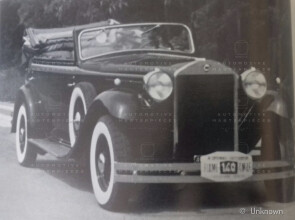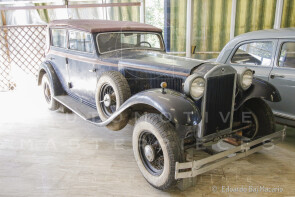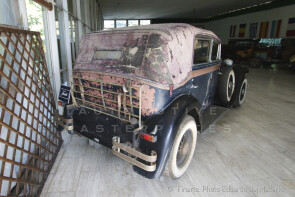
1931 Lancia Dilambda
ON/OFF
Why am I an Automotive Masterpiece?
L. Limited edition cars
no. 23 manufactured, 3rd built
The Dilambda, produced from 1928 to 1935, was the last of the Lancia cars named after letters of the Greek alphabet, a series that began with the very first car from the company, the Alfa of 1907. The Dilambda project started in 1926 when Vincenzo Lancia decided to create a successor to the Trikappa. Initially, the planned model was supposed to have a displacement around 3 liters. However, Vincenzo foresaw the opportunities that could open up for the Turin company by entering the vast U.S. automobile market, and, apparently without even informing his closest collaborators, he redirected the project toward a larger car. Convinced (and not wrongly) that a unibody structure would not be suitable for a large and heavy model, Monsù Lancia entrusted the technical department with the task of designing a chassis as robust and rigid as possible, while still applying the front independent suspension according to the proven Lambda design. The first box-section frame, patented in June 1927, was modified, and in January 1928, a further patent described the final Dilambda chassis: box-section frame rails, with an “X” cross member and a rear fuel tank functioning as a reinforcement beam. Key technical features included an 8-cylinder V engine at a 24° angle, with a 4-liter displacement, capable of 100 hp at 3800 rpm. According to the specialized press of the time, the Dilambda's greatest qualities were its smooth ride and, despite its size, its handling. The top speed ranged from 120 to 130 kilometers per hour, depending on the version. Among the many unique features of the Dilambda were the application of “silentbloc” joints, a special engine lubrication pump, a thermostat for regulating the cooling water temperature, and a “centralized” chassis lubrication system. A dozen “pre-production” examples were reportedly sent to New York to be displayed at Commodore Hall, but apart from prototypes and pre-series units, the Dilambda was officially presented at the Paris Motor Show in the fall of 1929. In production form, the Dilambda was offered as a sedan and a torpedo, but the real star was the bare chassis: it served as the base for many creations by top Italian and foreign coachbuilders. The model with a 347.5 cm wheelbase was known as “type 227” and was produced in two series from 1929 to 1931, with a total of 986 units: 879 from the first series and 107 from the second series. The “type 229” with a short wheelbase joined in 1931, and 418 units were built: 225 from the first series and 193 from the second series. In 1933, the final version, known as “type 232,” was introduced, still with a long wheelbase, and produced until 1935 with 281 units. These production numbers are likely correct but should be considered with some caution when it comes to individual versions. Between 1929 and 1935, nearly 1,700 Dilambda units were built—a seemingly modest number, but not insignificant considering the difficult economic period following the Wall Street crash and the fact that its selling price was almost prohibitive: twice that of an Artena and nearly four times that of a Fiat 514 Spyder. The Dilambda was also used as a service vehicle by the Royal Air Force.
The second series Dilambda, in both the long-wheelbase model 227 and the short-wheelbase model 229, began in the course of 1931 and continued until the end of 1932. Externally, the second series differed from the "first series" by the front grille, which was now similar to that of the final Lambda models, with vertical slats. Mechanical improvements included: upgrades to the braking system with the adoption of an Albert Dewandre brake servo and smaller but wider brake drums; new gear ratios, now with direct drive for the third and fourth gears, and a modified differential; instrument panel updates; and the adoption of 16 x 45 tires.
The Lancia Dilambda bodied by Pinin Farina, chassis no. 27-938, is the 22nd of the 2nd series. The Lancia records note that the assembly of this example was already completed in December 1930, but the final testing was only carried out in September 1931. It was commissioned by a Milanese client in 1932: Daniele Palazzoli, a wealthy businessman and owner of a namesake company in the food sector, who managed an important chain of stores, including Milan’s first supermarket/delicatessen. He was a well-known figure in the equestrian world of Brescia, surrounded by the most important aristocratic families in the area, including three of the four "musketeers" of the Mille Miglia: Maggi, Mazzotti, and Castagneto. Horses and motors intersected in the circles of the Unione Ippica Bresciana, where Comm. Daniele Palazzoli, a knowledgeable enthusiast, was active. At the Leno racecourse, known as the "San Siro" of Brescia, he established his own stable with numerous stalls. Palazzoli owned several estates scattered across the Bassa Bresciana and Emilia, including the renowned Martinenghe farm in Villachiara, where he undertook a vast modernization program, creating a model farm with modern stables and a horse track. Palazzoli was one of the four owners of racing stables in Brescia between the two world wars and a member of the national association of trotting horse breeders. An astute and aggressive entrepreneur, Palazzoli was also known for his lavish spending of his fortune. He was the first European breeder to import a trotting horse from the USA, and he did so in a daring manner. The horse’s name was Hazleton, and it was a legend of its time, perhaps even more than the more recent Varenne. Although Hazleton was already six years old and past his prime, the care provided by the breeder and his driver, Otto Diefenbaker, led the horse to win countless races, including, twice, the prestigious Grand Prix d'Amerique in Paris. In this environment of wealth and fame, Palazzoli treated himself in 1932 to an exceptional car: a Lancia Dilambda bodied by Pinin Farina, the chassis no. 27-938. It was a grand tourer, perfect for comfortable and fast travel between his properties and the most prestigious racetracks, but also a car to be admired in the center of Milan, as he sought to reinforce his status as a wealthy gentleman and not just a "salumiere" (grocer), as some detractors called him; a nickname that was particularly hurtful to his daughter Mara, later Selvini Palazzoli, who became a prominent psychiatrist and leader of the so-called "Scuola di Milano" or Milan Approach. Palazzoli ordered the car, specifying left-hand steering, which was rare on pre-1956 Lancias; this was the 3rd on a total of 23 LHD Dilambda mainly made for the US market. The body was a six-light fully openable cabriolet with winding windows, aluminum doors and bonnet sides. A Cabriolet Dilambda like this one had been the very first car ever to carry the signature of Battista "Pinin" Farina’s coachbuilding company. The Pinin Farina body of chassis no. 27-938 was finished in navy blue with light hazelnut belt moulding matching the soft top, and brown hide upholstery. Equipment included a side-mounted spare wheel, a large luggage grid and straps at the rear, Siata shock absorbers, headlamps with polygonal shells in the contemporary Lancia idiom, and twin tail lamps. The car featured a “Carbo” heating system, an independent coal-burning heater designed to warm the cabin. The heat was distributed through vents positioned on the floor, directing warm air towards the passengers' feet. This system provided effective heating even when the engine was off, though it required manual ignition and careful monitoring. The Dilambda, chassis no. 27-938, was always located in Milan and its surroundings, and is believed that during the 1930s it was loaned on more than one occasion to the City Governor for visits of V.I.P.s. It seems that both King Vittorio Emanuele III and dictator Benito Mussolini rode in it. In 1957, at the age of 75, Palazzoli decided to retire to a private life, affected by a sudden depression. The Dilambda, chassis no. 27-938, was sold three years later to Earl Salvatore Leto di Priolo, who provided to a light restoration, painting the fenders and lower part of the trunk in black. "Dore" was a well-known collector and gentleman driver who owned the car until June 17, 1972, when the Leto di Priolo brothers sold their car collection (29 cars, all but one a Fiat 8V) at an auction organized by Sotheby's at the automobile museum attached to the Monza racetrack. According to contemporary reports from Autocar magazine, the event took place in an atmosphere of anonymity, yet everyone knew everything. The car was purchased for the museum of the Terme Idroterapiche delle Saline di Miradolo, where it remained on display for fifty years, before being acquired by a private collector at another auction, this time organized by Finarte, in 2022. The car had been standing still for a very long time, and the new owner found an unrestored car in an exceptionally well-preserved state; even the five Englebert tyres on the car were said to be the originals, as well as the black Borrani wire wheels with an American-type Buffalo hub attachment, different from the European Rudge-Whitworth system. It still had its original Milano plate. A true historical testament. The car is currently under restoration.




